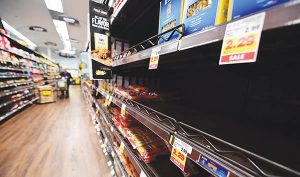Bloomberg
US store shelves got a little emptier in the last three months of 2021, according to data provider NielsenIQ, which is unveiling a barometer of out-of-stock goods amid ongoing supply constraints.
On-shelf availability slipped to 93.5% during the 13 weeks ending December 25 at supermarkets, mass retailers, drug stores and dollar stores, NielsenIQ said. That was a percentage point lower than in the previous 13-week period, as stores faced high demand, transportation snarls and Covid-19-related disruptions at suppliers.
During last year as a whole, retailers lost out on 7.4% of potential sales because of bare shelves, and this cost the industry $82 billion, NielsenIQ said. To help clients track the problem —and avoid angering shoppers —the consumer-data provider announced its new barometer of store shelves.
“The pandemic put a spotlight on on-shelf availability,†Jean-Baptiste Delabre, vice president of retail analytics at NielsenIQ, said in an interview. “This is really about getting as granular as possible, and if a product isn’t there, understanding why it isn’t there.â€
Detailed data from the barometer will be available biweekly to NielsenIQ clients. The company will publicly share information on broad trends after that.
Stocking problems aren’t equally distributed across the retail industry. During a wave of Covid-19 infections from late June to mid-October, the best performer in a selection of 10 companies was able to maintain more than 97% on-shelf availability, according to NielsenIQ. The worst managed less than 91%.
 The Gulf Time Newspaper One of the finest business newspapers in the UAE brought to you by our professional writers and editors.
The Gulf Time Newspaper One of the finest business newspapers in the UAE brought to you by our professional writers and editors.
